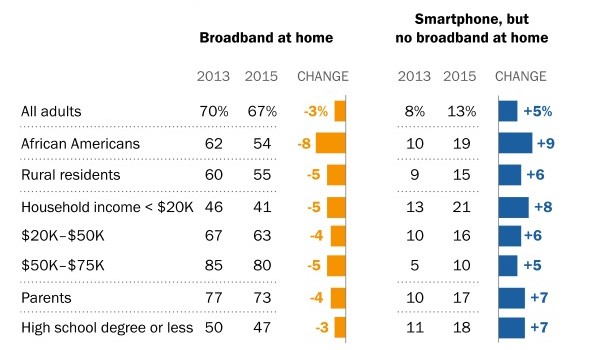
More people in the United States are connected to the Internet than ever before, but how they go online is changing dramatically. People in America are increasingly abandoning broadband connections and opting to go online using only their mobile devices, according to a new report by the Pew Research Center.
This may seem like a natural progression: More than two-thirds of adults in America are now smartphone owners. But it also represents a reversal for broadband connectivity, which had long been on the rise.
Two years ago, 70 percent of adults in America reported having broadband at home; today, 67 percent say they do. Over the same time period, the percentage of people who said they have a smartphone but no broadband at home jumped from 8 percent to 13 percent.
These shifts are particularly pronounced among black people and those who live in rural areas. Two years ago, 62 percent of African Americans said the had broadband at home; today, their home-broadband use is down to 54 percent. Smartphone-only Internet connectivity among African Americans went from 10 percent to 19 percent over the same time.
Pew found a similar pattern among people who live in rural areas. In 2013, 60 percent of them had broadband; today, 55 percent of them do. And in 2013, 9 percent of them went online using only a smartphone; today 15 percent of them do. Another demographic that was more likely to go smartphone-only: people with kids. Two years ago, 10 percent of parents reported being smartphone-only Internet users; today, 17 percent say they are.
Income level also appears to play a role. Those who reported making anywhere from under $20,000 per year to $75,000 per year were consistent in how rapidly they’re dropping broadband, but the people who made the least money were far more likely to report more smartphone-only Internet connections in the past two years.
Shifts in Home Internet Connectivity

And though technologists have long said that a society-wide shift to mobile is underway, relying only on a smartphone to go online entails distinct challenges.
“Those who are ‘smartphone dependent,’ for access,” the Pew report says, “are more likely than other users to run up against data-cap limits that often accompany smartphone service plans.” At the same time, the cost of broadband service is the main reason why those who don’t have it choose not to, Pew found.
All this is happening at a time when more people see home Internet connectivity as essential, especially those who don’t have broadband. In the past five years, there has been a “substantial increase” of adults who say not having high-speed Internet at home is a major disadvantage when looking for job opportunities, health information, or accessing other key data. “Today two-thirds (65 percent) of non-adopters say that lacking home broadband service is a major disadvantage in at least one of these areas, compared with just under half (48 percent) who said so in 2010,” Pew said.
The profound shift in how people go online coincides with a different kind of cord-cutting: Some 15 percent of American adults have ditched cable television and an additional 9 percent of them say they’ve never had it at all, many of them citing the availability of programming through online services like Netflix.
Smartphones play a role in this shift, too. Fully three-quarters of cable-television “cord-cutters” are smartphone owners, a higher percentage than overall smartphone owners in the United States. For both television and Internet connectivity, Pew finds, “large numbers of non-broadband households have never had home high-speed service in the past, and few have interest in subscribing in the future.”
Related Video
A snapshot of a young man's life, filmed from the perspective of his phone